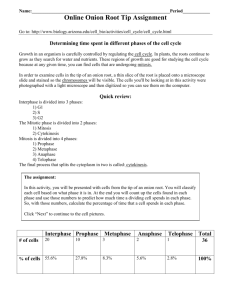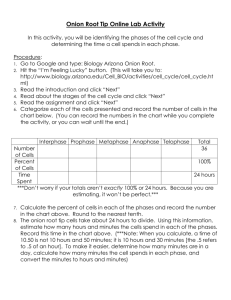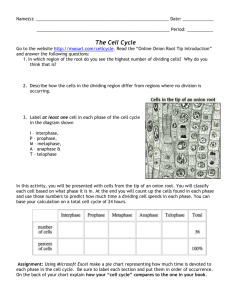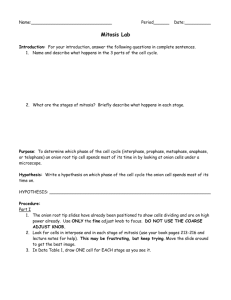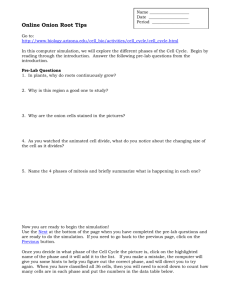Onion Root Tip Lab
advertisement
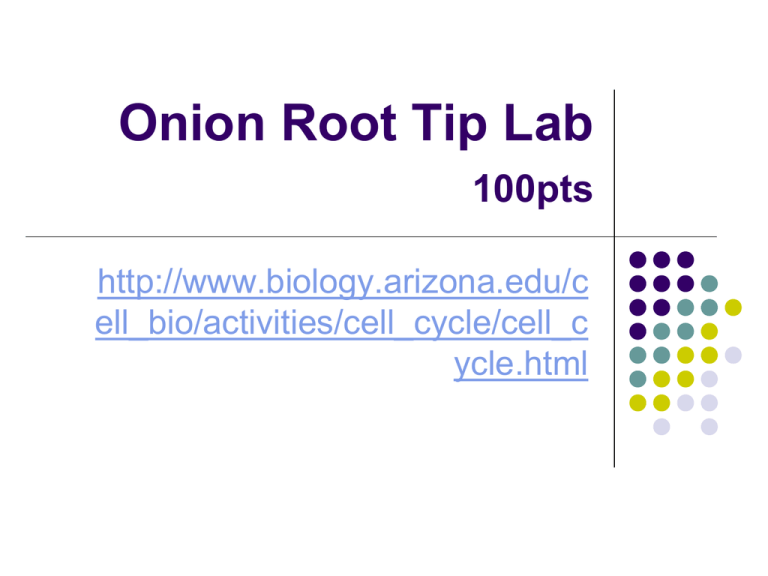
Onion Root Tip Lab 100pts http://www.biology.arizona.edu/c ell_bio/activities/cell_cycle/cell_c ycle.html Objectives Calculate how long a cell stays in a particular stage of the cell cycle. Calculate percentages. Translate this into real time. Infer why a cell would spend the amount of time it does in each stage. Essential Questions How long does a cell spend in each stage of the cell cycle? Why does the cell spend so much of its time in a particular stage? Plant Mitosis -- Review Prophase Interphase Interphase Metaphase Anaphase Telophase Overview Growth in an organism is carefully controlled by regulating the cell cycle. In plants, the roots continue to grow as they search for water and nutrients. These regions of growth are good for studying the cell cycle because at any given time, you can find multiple cells that are undergoing some stage of mitosis. In order to examine cells in the tip of an onion root, a thin slice of the root is placed onto a microscope slide and stained so the chromosomes will be visible. The cells you'll be looking at in this activity were photographed with a light microscope and then digitized so you can see them. Overview Although slicing the onion root captures many cells in different phases of the cell cycle, keep in mind that the cell cycle is a continuous process. Scientists have divided the process into 6 phases, each characterized by important events, but these divisions are still arbitrary as a cell is a fluid environment constantly changing. On to the exercise Today, you are going to study an onion root tip to identify the time cells spend in different phases of the cell cycle. Review the major phases of the cell cycle. Interphase Mitosis Prophase Metaphase Anaphase Telophase Cytokinesis We’ll be concentrating on these. Prediction My first question to you is how do you think you can determine a realistic amount of time a cell spends in a particular stage of the cell cycle based on an image? It depends on the % of cells in each stage at any particular point in time. For example, for these cells, if 50% are in interphase we can guesstimate that these cells spend 50% of their time in that phase. Every one of them will exhibit this behavior. Make your prediction. Develop and write down a hypothesis that we can use for this experiment on top of your chart. Predict which stage you think the cell spends the most time in. Remember, this hypothesis will serve as a prediction that can be tested. Keep in mind the question: How long does a cell spend in each stage of the cell cycle? Your prediction will be an educated guess on how many hours (out of 24) does a onion root tip spend in each phase. The Method You will study individual slides, each taken from a larger sample of an onion root tip that was photographed during natural development. By determining the number of total cells in each phase and dividing this number by the total number of cells one could calculate and predict a general average of how long each particular cell stays in each stage. If you haven’t done so already, copy this table onto a piece of paper. You can enter data in this table as you go along, or at the end of the activity. Interphase Prophase Metaphase Anaphase Telophase Total Predicted time in phase 24hrs Number of cells (Data) 77 Percent of cells (Results) 100% Actual calculated time 24hrs Decide which phase each numbered cell is. IF YOU THINK THE CELL IS IN 1. Anaphase CYTOKINESIS THEN COUNT IT AS 2 CELLS IN INTERPHASE. 2. Interphase 3. Telophase 4. Prophase 5. Metaphase 3 1 5 IF YOU CAN’T TELL IT’S IN INTERPHASE 2 4 THIS IS DUE TOMORROW THE NUCLEOLUS IS THE FEATURE OF A CELL IN INTERPHASE The Assignment In this activity, you will be presented with cells from the tip of an onion root. You will classify each cell based on what phase it is in. At the end you will count up the cells found in each phase and use those numbers to predict how much time a dividing cell spends in each phase. You can base your calculation on a total cell cycle of 24 hours. We will use the data we gather in order to determine the % of cells in each phase, yes, but also to predict the amount of time a cell spends in these phases, on average based upon a 24-hour life. At this time, fill in the predicted amount of time you think a cell spends in each phase of the chart (together they should equal 24 hours). You will use a small sample size for time, but this experiment has been repeated thousands of times with thousands of root tips and has been found to be a good predictor of average cellular activity.

